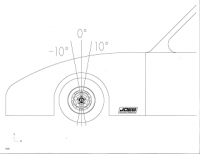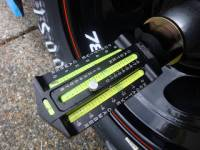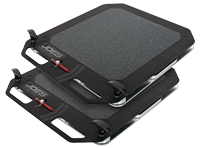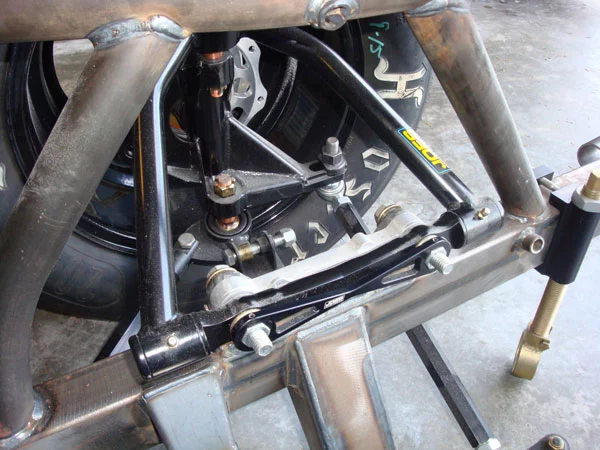Why do we need a caster? The most direct answer is for directional stability. Without caster our racecars would wander, in an unstable fashion, on the straights and be hard to handle at high speed corner entry. Positive Caster allows the front wheels to trail behind the caster line for true tracking. Extending a line from the top ball joint though the bottom ball joint creates the caster line or caster angle. If the line extends forward of the lower ball joint and contact patch you have positive caster – behind is negative caster and both are measured in degrees. Positive caster allows the wheel to trail behind the line for stability. The most common and easy to understand example is a shopping cart wheel. As soon as you move your shopping cart forward – the front wheels spin and trail behind the positive caster angle.
Caster is measured in degrees
 Caster is measured in degrees. When a line is extended from the top ball joint through the bottom ball joint the caster line is created. Zero caste would be when the upper and lower ball joints create a line that is perfectly vertical. Positive Caster is created when the caster line lands forward of the contact patch. Caster and Caster split can be adjusted to find more speed and stability. A common example of caster is a shopping cart. As the shopping cart is pushed forward the front wheels spin back and trail behind the caster line.
Caster is measured in degrees. When a line is extended from the top ball joint through the bottom ball joint the caster line is created. Zero caste would be when the upper and lower ball joints create a line that is perfectly vertical. Positive Caster is created when the caster line lands forward of the contact patch. Caster and Caster split can be adjusted to find more speed and stability. A common example of caster is a shopping cart. As the shopping cart is pushed forward the front wheels spin back and trail behind the caster line.
Caster creates stability as the geometry created forces the wheels back to straight. The front wheels are “encouraged” to stay straight as turning them involves lifting the car weight. Expensive street cars often have high amounts of positive caster providing them with a superior and stable feel. The drawback comes in the form of added steering effort. The invention of power steering has allowed for more caster to be added. When power steering fails it is easy to see the negative effects. As soon as the dripping wet driver gets out of the car and asks for help opening a beer due to his arms being worn out it becomes clear how power steering has allowed higher amounts of caster.
In stock cars, we can use caster to help our cars going beyond simple directional stability. Caster split is often used as a chassis adjustment. Running more positive caster on the right than on the left is common. The question is how much split and how much positive caster should you run?
Caster split and the appropriate amount chosen is one of those chassis adjustments where there is not a magic amount or a right or wrong answer. If you understand the effects of caster split you can make your own decisions based on your track, driver and goals. Commonly crew chiefs run 3 degrees positive on the right side and 1 degree positive on the left side. At times it may pay to run 4 or 5 degrees on the right and .5 degrees positive on the left. It all depends on what you are hoping to accomplish for your specific chassis needs.
An often overlooked element relating to stock car caster is that the more positive caster you run the more “beneficial” camber gain you will get. As the car rolls you will see more negative camber gain on the right side and more positive camber gain on the left in lock step with running additional caster. Camber gain through travel is typically a good thing but like all adjustments you want to avoid going too far. If you are aggressive with A-Arm lengths that create high amounts of camber gain you want to be careful that you do not get to aggressive with caster. As always balance applies.
Speed Secrets
 You can find a “speed secret” by understanding that more caster beneficially adds to negative camber gain on the right front and more positive camber gain on the left front. You can check this effect by measuring your camber gain at your current setting and recording the numbers. Next – add caster and check your camber gain again and you will see the benefits visually right in the shop. With the knowledge you can tailor your set up package to overcome obstacles presented by your car, track and driver.
You can find a “speed secret” by understanding that more caster beneficially adds to negative camber gain on the right front and more positive camber gain on the left front. You can check this effect by measuring your camber gain at your current setting and recording the numbers. Next – add caster and check your camber gain again and you will see the benefits visually right in the shop. With the knowledge you can tailor your set up package to overcome obstacles presented by your car, track and driver.
To visualize the benefit of the caster induced camber gain it pays to think in extremes. If you are running 3 degrees of positive caster on the right this would be in the normal range. For our visualization, picture adding caster until the caster line is adjusted an exaggerated amount until it becomes completely horizontal. At this hypothetical and exaggerated point, the result would be pure camber change instead of directional change. The benefit is that with more static caster, the right front wheel would gain more negative camber as steering input is increased. The left front wheel gains more positive camber as the wheel is turned. Cool, we get more camber gain when we need it most by running more caster through a left hand turn! Even experienced crew chiefs can be unaware of the relation to caster and beneficial camber gain in left hand turns. Personally, I find understanding the camber gain from caster to be a true “speed secret”.
Running more caster on the right side verses the left is an adjustment tool that can help cars turn left. The amount of caster split can create benefits as the wheels are turned. More split will “de-wedge” the car at maximum steering input helping the car to turn in the middle. As the steering wheel is un-wound – wedge is added back helping the car to hook up better on exit. Wedge is added back as the wheels return to straight or even back through to the right. You can easily see this change when you have the car on scales. The next time you weigh your car and you have recorded your race ready numbers simply turn the steering wheel 10 degrees left and you will see your scale numbers display less wedge when the wheels are turned left.
Use turn plates to help measure caster
 You can use turn plates to help measure caster. Using a quality caster camber gauge the turn plates allow you to turn the wheels exactly 20 degrees for precise caster measurements. You can also use the turn plates to visually see the caster induced camber gain when running higher amounts of caster. Simply check the camber gain with the wheels straight and compare the camber gain numbers to your results with the wheels turned 10 degrees left.
You can use turn plates to help measure caster. Using a quality caster camber gauge the turn plates allow you to turn the wheels exactly 20 degrees for precise caster measurements. You can also use the turn plates to visually see the caster induced camber gain when running higher amounts of caster. Simply check the camber gain with the wheels straight and compare the camber gain numbers to your results with the wheels turned 10 degrees left.
Based on the prior paragraphs it would make sense to run high amounts of caster and plenty of caster split yet understanding the concept will create speed whereas just throwing in aggressive settings could set introduce problems – it pays to understand your changes in advance. Too much of a good thing leads to trouble. There are many variables to consider when it comes to caster amount and split. You must consider other geometry choices such as A-Arm length to avoid ending up with too much camber gain. Too much split can make the car pull too hard to the left making the car tough to control in traffic and on corner entry.
You can thank power steering for creating options with high amounts of caster. Power steering overcomes the steering effort and in the past high amounts of caster was simply not possible as the effort required wore out the driver in a handful of laps. Prior to power steering it was quite common to run negative caster on the left front to reduce steering effort.
For less experienced drivers, I recommend running as much caster split as you can get away with. Something in the neighborhood of 4 positive on the right and 1 positive on the left will help your rookie driver. The idea is that the split will help them to catch the car when it gets loose preventing them from spinning out. As the rookie drive unwinds the wheel wedge is automatically added back in giving the rookie a little help anticipating the loose car before they go for a ride. The split gets wedge back in the car quickly as they correct back to the right giving them security and a helping hand. For rookies, I might compromise my faster caster set up to ensure they finish races. Giving rookies caster split builds their confidence and helps to prevent them from getting behind on the steering.
Use slotted A-Arms
 On most stock cars the top A-Plate is set back to build in the positive caster that most people run. Using slotted A-Arms and slugs makes for quick and consistent adjustments at the track or in the shop.
On most stock cars the top A-Plate is set back to build in the positive caster that most people run. Using slotted A-Arms and slugs makes for quick and consistent adjustments at the track or in the shop.
For experienced drivers, that have a good feel, I might reduce the caster split. The chassis premise is that you know your good driver and you can allow him or her to drive the car without interference from overdone geometry. Again, there is much to consider and other chassis goals would easily override this choice. The experienced driver feels the car and sometimes wants the control in their hands as they anticipate with confidence. In this case, they want to turn the wheel for the desired effect verses being forced into a geometry change that happens outside of their steering input control.
I would push the window on caster amounts and splits on tracks that are smooth and with sweeping corners. If the driver can consistently turn in and unwind the wheel smoothly then adding caster and split can help find speed due to the geometric benefits discussed.
All that said – caster and caster split is very much car, track and driver specific. In much of the country our short tracks are worn out, bumpy and the corner transitions can be abrupt. For rough tracks where drivers are constantly sawing on the wheel, too much caster and caster split can cause the car to be erratic. All the directional change from a steering wheel that is being turned back and forth quickly will upset the car. You can imagine that turning the wheel quickly back and forth would inconsistently put wedge in then out, back and forth steering input would add camber gain then abruptly take it out.
At rough tracks or if your driver nervously saws on the wheel – you will definitely create too much of a good thing resulting in a car that never knows quite what to do and stability is lost. Many of the races my cars won were on rough tracks and I commonly ran 2 degrees positive on the right and .5 degrees positive on the left. The idea was to keep the consistency in the car over the bumps and through quick back and forth steering input. I truly believe this to be one of my speeds secrets at rough tracks. Maybe my competition was being aggressive with their front end settings causing their cars to fade later in the race on the worn out surfaces. That is why they throw the green and checkered flag as there is not a right and wrong here but simply a competitive choice.
Your team can analyze your track, car and driver to see if the benefits of added caster and caster split would overcome obstacles that you face. Used properly there is plenty of speed to be found in the correct caster settings. Your job is to understand the changes through chassis roll. Through understanding you can use caster to create speed and your additional “planned” choices will give you an edge over your competition.
